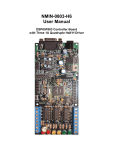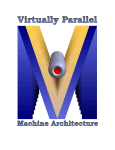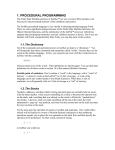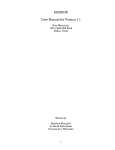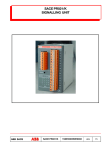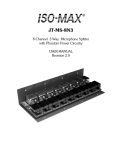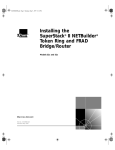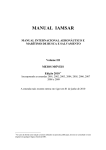Download NMIN-0803-Mini User Manual
Transcript
NMIN-0803-MINI DSP56F803 Controller Board User Manual Warranty New Micros, Inc. warrants its products against defects in materials and workmanship for a period of 90 days. If you discover a defect, New Micros, Inc. will, at its option, repair, replace, or refund the purchase price. Simply call our sales department for an RMA number, write it on the label and return the product with a description of the problem. We will return your product, or its replacement, using the same shipping method used to ship the product to New Micros, Inc. (for instance, if you ship your product via overnight express, we will do the same). This warranty does not apply if the product has been modified or damaged by accident, abuse, or misuse. Copyrights and Trademarks Copyright © 2002 by New Micros, Inc. All rights reserved. NMIN-0803-Mini, IsoMax™ and Virtually Parallel Machine Architecture™ are trademarks of New Micros, Inc. Windows is a registered trademark of Microsoft Corporation. 1-wire is a registered trademark of Dallas Semiconductor. Other brand and product names are trademarks or registered trademarks of their respective holders. Disclaimer of Liability New Micros, Inc. is not responsible for special, incidental, or consequential damages resulting from any breach of warranty, or under any legal theory, including lost profits, downtime, goodwill, damage to or replacement of equipment or property, and any costs of recovering, reprogramming, or reproducing any data stored in or used with New Micros, Inc. products. Internet Access Web site: http://www.newmicros.com This manual: http://www.newmicros.com/store/product_manual/nmin-0803-mini.pdf Email technical questions: [email protected] Email sales questions: [email protected] Also see “Manufacturer” information near the end of this manual. Internet NMIN-0803-Mini Discussion List We maintain the NMIN-0803-Mini discussion list on our web site. Members can have all questions and answers forwarded to them. It’s a way to discuss NMIN-0803-Mini issues. To subscribe to the NMIN-0803-Mini list, visit the Discussion section of the New Micros, Inc. website. http://www.newmicros.com/discussion/ This manual is valid with the following software and firmware versions IsoMax V0.5 or newer. or (c) 2000-2001 Motorola Inc. S-Record loader. Version 1.3 If you have any questions about what you need to upgrade your product, please contact New Micros, Inc. NMIN-0803-Mini User Manual 2 Table of Contents 1 GETTING STARTED ........................................................................................................................ 5 1.1 1.2 1.3 INSTRUCTIONS FOR ISOMAX USERS .................................................................................................. 7 INSTRUCTIONS FOR USERS WITH SMALL C AND A JTAG CABLE .................................................... 11 INSTRUCTIONS FOR USERS WITH SMALL C WITHOUT A JTAG CABLE ............................................ 11 2 QUICK TOUR .................................................................................................................................. 11 3 CIRCUIT DESCRIPTION............................................................................................................... 13 3.1 3.2 3.3 3.4 3.5 RS-232 LEVELS TRANSLATION....................................................................................................... 13 CAN BUS LEVELS TRANSLATION .................................................................................................. 13 LED’S ............................................................................................................................................. 13 RESET ........................................................................................................................................... 14 POWER SUPPLY.......................................................................................................................... 14 4 TROUBLE SHOOTING .................................................................................................................. 15 5 ONLINE RESOURCES ................................................................................................................... 16 5.1 5.2 5.3 5.4 6 NMIN-0803-MINI WEBSITE ............................................................................................................ 16 MAXFORTH™ GLOSSARY REFERENCE PAGE ............................................................................... 16 MOTOROLA DSP56F803 USERS MANUAL ...................................................................................... 16 MOTOROLA DSP56F800 PROCESSOR REFERENCE MANUAL .......................................................... 16 CONNECTORS ................................................................................................................................ 16 6.1 6.2 6.3 6.4 6.5 6.6 6.7 6.8 6.9 J1 PWM, QUAD ENCODER & INTERRUPTS ..................................................................................... 17 J2 CAN BUS SPEED CONTROL ....................................................................................................... 18 J4 RS232 DIS/ENABLE ................................................................................................................... 18 J5 POWER & GROUND .................................................................................................................... 18 J3 CAN BUS .................................................................................................................................. 18 J6 JTAG CONNECTOR ..................................................................................................................... 18 J7 RS232 ........................................................................................................................................ 19 J8 ADC........................................................................................................................................... 19 J9 SHARED I/O & LCD CONNECTION ............................................................................................. 19 7 MANUFACTURER.......................................................................................................................... 20 8 MECHANICAL ................................................................................................................................ 20 9 ELECTRICAL .................................................................................................................................. 20 10 EMBEDDED SOFTWARE DEVELOPMENT.............................................................................. 22 10.1 OVERVIEW ................................................................................................................................. 22 10.2 ISOMAX ..................................................................................................................................... 22 10.3 COMPILER & ASSEMBLER .......................................................................................................... 22 10.3.1 With JTAG ............................................................................................................................ 23 10.3.2 With Serial Bootloader ......................................................................................................... 23 11 PC COMMUNICATION ................................................................................................................. 27 11.1 11.2 11.3 12 NMITERM .................................................................................................................................. 27 MAXTERM ................................................................................................................................. 28 HYPERTERMINAL ....................................................................................................................... 29 REFERENCE.................................................................................................................................... 30 NMIN-0803-Mini User Manual 3 12.1 12.2 DECIMAL / OCTAL / HEX / ASCII CHART .................................................................................. 30 SIMPLE ASCII CHART................................................................................................................ 32 13 GLOSSARY ...................................................................................................................................... 33 14 ARTICLES AND SUGGESTED READING ................................................................................. 34 15 MECHANICAL DRAWING ............................................ ERROR! BOOKMARK NOT DEFINED. 16 SCHEMATIC ……………………………………………………………………………………….35 Table Of Figures FIGURE 1 – NMIN-0803-MINI ........................................................................................................................ 5 FIGURE 2 – POWER AND SERIAL CONNECTIONS .............................................................................................. 6 FIGURE 3 – THE SERIAL CABLE ...................................................................................................................... 7 FIGURE 4 – THE POWER CABLE ...................................................................................................................... 7 FIGURE 5 – THE LEDS .................................................................................................................................... 8 FIGURE 6 – RED LED OFF ............................................................................................................................... 9 FIGURE 7 – RED LED ON ................................................................................................................................ 9 FIGURE 8 – GREEN LED OFF ......................................................................................................................... 10 FIGURE 9 – GREEN LED ON .......................................................................................................................... 10 FIGURE 10 – BOARD FEATURES .................................................................................................................... 12 FIGURE 11 – CONNECTOR J1 ......................................................................................................................... 17 FIGURE 12 – CONNECTORS J2, J3, J4, J5 AND J6 .......................................................................................... 18 FIGURE 13 – CONNECTORS J7, J8 AND J9 ..................................................................................................... 19 FIGURE 14 – EMBEDDED SOFTWARE DEVELOPMENT OVERVIEW.................................................................. 22 FIGURE 15 – SOFTWARE DEVELOPMENT USING ISOMAX .............................................................................. 22 FIGURE 16 – SOFTWARE DEVELOPMENT USING JTAG.................................................................................. 23 FIGURE 17 – SOFTWARE DEVELOPMENT USING SERIAL BOOTLOADER ......................................................... 23 Tables TABLE 1 - CONNECTORS ............................................................................................................................... 12 TABLE 2 - ABSOLUTE MAXIMUM RATINGS ................................................................................................... 20 TABLE 3 - RECOMMENDED OPERATING CONDITIONS.................................................................................... 21 TABLE 4 - DC ELECTRICAL CHARACTERISTICS ............................................................................................ 21 NMIN-0803-Mini User Manual 4 1 GETTING STARTED Thank you for buying the NMIN-0803-Mini. We hope you will find the NMIN-0803Mini to be the incredibly useful small controller board we intended it to be, and easy to use as possible. If you are new to the NMIN-0803-Mini, we know you will be in a hurry to see it working. That’s okay. We understand. Figure 1 – NMIN-0803-Mini Let’s skip the features and get right to the operation. Once we’ve got communications, then we can make some lights blink and know for sure that we’re in business. Let’s make this “Mini board” talk to us! We’ll need PC running a terminal program. Then we’ll need a serial cable to connect from the PC to the NMIN-0803-Mini (which, hopefully, you’ve already gotten from us). Then we need power, such as from a 6VDC wall transformer (which, hopefully, you’ve NMIN-0803-Mini User Manual 5 already gotten from us. If we have those connections correct, we will be able to talk to the NMIN-0803-Mini interactively. The wall transformer can supply the power to the NMIN-0803-Mini board, but do not connect it to the board yet. The board can be seen in the figure below, showing the connections of VIN and GND. Connect the serial cable between the J7 connector and the PC. The J7 upper row pinout can also be seen in the figure. Figure 2 – Power and Serial Connections Once you have your serial cable and connectors, and wall transformer and connectors ready, follow these steps. Start with the PC. Install (if not already installed) and run the terminal communications program - MaxTerm or NMITerm or HyperTerminal. Set the program for the desired communications channel (COM1, COM2, etc.), and set the communications parameters to 9600, 8N1. Operate the program to get past the opening setups and to the terminal screen, so it is ready to communicate. (If necessary, visit the section on PC Communication if you have trouble understanding how to accomplish any of this.) Hook the computer end of the serial cable (usually a DB-9 connector, but may be a DB25, or other, on older PC’s) to the PC’s communication channel selected in the terminal program. A simple serial cable can be made with Digikey part CFP09T-ND (a female D sub 9), CSC10T-ND (a 10 pin female connector), and a short length of 10 circuit ribbon cable. NMIN-0803-Mini User Manual 6 Figure 3 – The Serial Cable Plug the wall transformer into the wall, but do not plug it into the board yet. Figure 4 – The Power Cable 1.1 Instructions for IsoMax Users Now, while watching the LED’s plug in the wall transformer connector to the power pins on the NMIN-0803-Mini board. Be very careful not to plug it in reverse polarity here, even though the regulator, LM2937 has the reverse voltage protection. Both the Red and Green LED’s should come on. If the LED’s do not light, unplug the power to the NMIN-0803-Mini quickly. NMIN-0803-Mini User Manual 7 Figure 5 – The LEDs If the LED glows, then check the screen on the computer. When the power is applied, before any user program installed, the PC terminal program should show, “IsoMax™V0.5” (or whatever the version currently is, see upgrade policy later at the end of this chapter), or “© 2000-2001 Motorola Inc. S-Record loader. Version 1.3” . If the LED’s don’t light, and the screen doesn’t show the message, unplug the power to the NMIN-0803-Mini. Check the power connections, particularly for polarity. (This is the most dangerous error to your board.) If the LED’s come on but there is no communication, check the terminal program. Check the serial connections, particularly for a reversal or rotation. Try once more. If you have no success, see the trouble shooting section of this manual and then contact technical support for help, before going further. Do not leave power on the board for more than a few seconds if it does not appear to be operational. Normally at this point you will see the prompt on the computer screen “IsoMax™ V0.5”, or “© 2000-2001 Motorola Inc. S-Record loader. Version 1.3”. Odds are you’re there. Congratulations! Now let’s do something interactive with the NMIN-0803-Mini. To start with IsoMax programming, in the terminal program on the PC, type in, “WORDS” (all in “caps” as the language is case sensitive), and then hit “Enter”. A stream of words in the language should now scroll up the screen. Good, we’re making progress. You are now talking interactively with the language in the NMIN-0803-Mini. Now let’s blink the LED’s. Port lines control the LED’s. Type: REDLED OFF NMIN-0803-Mini User Manual 8 Figure 6 – Red LED off To turn it back on type: REDLED ON Figure 7 – Red LED on Now let’s use the Green LED. Type: GRNLED OFF NMIN-0803-Mini User Manual 9 Figure 8 – Green LED off To turn it back on type: GRNLED ON Figure 9 – Green LED on Now you should have a good feeling because you can tell your NMIN-0803-Mini is working. It’s time for an overview of what your NMIN-0803-Mini has for features. First though, a few comments on IsoMax™ revision level. The first port of IsoMax™ to the NMIN-0803-Mini occurred on May 27, 2002. We called this version V0.1, but it never shipped. While the core language was functional as it then was, we really wanted to add many I/O support words. We added a small number of words to identify the port lines and turn them on and off and shipped the first public release on June 3, 2002. This version was V0.2. Currently we are shipping V0.5 . As we approach a more complete NMIN-0803-Mini User Manual 10 version, eventually we will release V1.0. We want all our original customers to have the benefit of the extensions we add to the language. Any NMIN-0803-Mini purchased prior to V1.0 release can be returned to the factory (at customer’s expense for shipping) and we will upgrade the V0.x release to V1.0 without charge. 1.2 Instructions for Users with Small C and a JTAG Cable A Small C program will have been flashed to the 803-Mini by NMI prior to shipping. When you connect the power to the board, you should observe the red LED and the green LED are both ‘on’. After 10 seconds, the green LED flashing, and the red LED is stayed steady ‘on’ – this proves that the board is working. This test program is listing on section 10.4 page 23. 1.3 Instructions for Users with Small C without a JTAG Cable The 803-Mini will contain the Serial Bootloader, and this will have been used by NMI to flash the test program, as detailed in the above section. To ensure correct operation of the board, connect the Serial Cable to your PC (and the 803-Mini) and run the desired communications program with the following settings – 115200 baud, 8 bits, no parity, 1 stop bit, Xon/Xoff flow control. When you connect the power to the board, a message will be displayed via the communications program on your PC saying that the Serial Bootloader has started. Note: there will be a 10 seconds delay, and then the test program will run. You should then observe the red LED ‘on’ and the green LED flashing – this proves that the board is working 2 QUICK TOUR Start by comparing your board to the diagram below. Most of the important features on the top board are labeled. NMIN-0803-Mini User Manual 11 Figure 10 – Board Features The features most important to you will be the connectors. The following list gives a brief description of each connector and the signals involved. Table 1 - Connectors J1 J2 J3 J4 J5 J6 J7 J8 J9 PWM’s, Quad encoder, and interrupts CAN BUS Speed control CAN BUS Network Port unavailable V + & Ground JTAG connector RS-232 Serial Port A/D Shared I/O’s & LCD connection The table above explains the type of connection that can be made to each of the connectors. As it can be seen from the table there os no connector assigned for J4. The power reset and ground can be used externally for various applications. All the connectors are dual or triple row male headers. Connection can be made with female headers with crimped wire inserts, or IDC headers with soldered or cabled wires. Signals were put on separate connectors where possible, such as with the RS-232, the Can Bus, and PWM connectors. The male headers allow insertion of individually handNMIN-0803-Mini User Manual 12 crimped wires in connectors where signals are combined. For instance, R/C Servo motor headers often come in this size connection with a 3x1 header. These can plug directly onto the board side by side on the PWM connector. The large chip at the center of the board is the CPU (DSP56F803). The two LED’s, Red and Green, are along the bottom of the CPU, and are dedicated to user control. On the back of the board the components are the voltage regulators. If the total current draw were smaller, we could make a smaller supply, but to be sure every user could get enough power to run at full speed, these larger parts were necessary. A few smaller chips are also on the board, the RS-232 transceiver and the LED driver, and a handful of resistors and capacitors. 3 CIRCUIT DESCRIPTION The processor chip contains the vast majority of the circuitry. The remaining support circuitry is described here. The power for the system can be handled several different way, but as the board comes, power will normally be supplied from the VIN pin on board. 3.1 RS-232 Levels Translation The MAX3221 converts the 3.3V supply to the voltages necessary to drive the RS-232 interface. Since a typical RS-232 line requires 10 mA of outputs at 10V or more, the MAX3221 uses about 30 mA from the 3.3V supply. A shutdown is provided, controlled by TD1. http://pdfserv.maxim-ic.com/arpdf/MAX3221-MAX3243.pdf 3.2 CAN BUS Levels Translation A TJA1050 buffers the CAN BUS signal. http://my.semiconductors.com/acrobat/datasheets/TJA1050_3.pdf 3.3 LED’s A 74HC04 drives the on-board LED’s. Each LED has a current limiting resistor to the +3.3V supply. http://www.fairchildsemi.com/ds/74/74AC05.pdf NMIN-0803-Mini User Manual 13 3.4 RESET A S80728HN Low Voltage Detector asserts reset when the voltage is below operating levels. This prevents brown out runaway, and a power-on-reset function. http://www.seiko-instruments.de/documents/ic_documents/power_e/s807_e.pdf 3.5 POWER SUPPLY A LM2937 reduces the VIN DC to a regulated 5V. In early versions a 7805C was used. The LM2937 was rated a bit less for current (500 mA Max), but had reverse voltage protection and a low drop out which was more favorable. A drops the 5V to the 3.3V needed for the processor. At full current, 180 mA, these two regulators will get hot. They can provide current to external circuits if care is taken to keep them cool. Each are rated at 1A but will have to have heat sinking added to run there. http://www.national.com/ds/LM/LM2937.pdf http://www.national.com/ds/LM/LM3940.pdf NMIN-0803-Mini User Manual 14 4 TROUBLE SHOOTING There are no user serviceable parts on the NMIN-0803-Mini. If connections are made correctly, operation should follow, or there are serious problems on the board. As always, the first thing to check in case of trouble is checking power and ground are present. Measuring these with a voltmeter can save hours of head scratching from overlooking the obvious. After power and ground, signal connections should be checked next. If the serial cable comes loose, on either end, using your PC to debug your program just won’t help. Also, if your terminal program has locked up, you can experience some very “quiet” results. Don’t overlook these sources of frustrating delays when looking for a problem. They are easy to check, and will make a monkey of you more times than not, if you ignore them. One of the great advantages of having an interactive language embedded in a processor, is if communications can be established, then program tools can be built to test operations. If the RS-232 channel is not in use in your application, or if it can be optionally assigned to debugging, talking to the board through the language will provide a wealth of debugging information. The LED’s can be wonderful windows to show operation. This takes some planning in design of the program. A clever user will make good use of these little light. Even if the RS-232 channel is in use in your application and not available for debugging, don’t overlook the LED’s as a way to follow program execution looking for problems. The NMIN-0803-Mini is designed so no soldering to the board should be required, and the practice of soldering to the board is not recommended. Instead, all signals are brought to connectors. So, the best trouble shooting technique would be to unplug the NMIN-0803-Mini and try to operate it separately with a known good serial cable on power supply. If the original connections have been tested to assure no out-of-range voltages are present, a second NMIN-0803-Mini can then be programmed and plugged into the circuit in question. But don’t be too anxious to take this step. If the first NMIN-0803-Mini should be burned out, you really want to be sure you know what caused it, before sacrificing another one in the same circuit. Finally, for advanced users, the JTAG connection can give trace, single step and memory examination information with the use of special debugging hardware. This level of access is beyond the expected average user of the NMIN-0803-Mini and will not be addressed in this manual. NMIN-0803-Mini User Manual 15 5 Online Resources 5.1 NMIN-0803-Mini Forum & Technical Support http://www.newmicros.com/discussion/ 5.2 NMIN-0803-Mini Manual http://www.newmicros.com/store/product_manual/nmin-0803-mini.pdf 5.3 Small C & Assembler website http://home.attbi.com/~petegray/ 5.4 MaxFORTH™ Glossary Reference Page http://www.ee.ualberta.ca/~rchapman/MFwebsite/V50/Alphabetical/Brief/index.html This has explanations for the definitions for the procedural language "under" the IsoMax(TM) Finite State Machine language. 5.5 Motorola DSP56F803 Users Manual http://e-www.motorola.com/brdata/PDFDB/docs/DSP56F801-7UM.pdf 5.6 Motorola DSP56F800 Processor Reference Manual http://e-www.motorola.com/brdata/PDFDB/docs/DSP56800FM.pdf 6 CONNECTORS The NMIN-0803-Mini has 8 connectors. J1, J2, J3, J5, J6, J7, J8, J9 are below: J1 PWM, Quad Encoder & Interrupts PWM, V+, GND, Quad, Faults, ISx, IRQx J2 CAN BUS Speed Control Jumper High/Low J3 CAN BUS Network Port CANL, CANH, GND J4 unavailable J5 Reset, +5V, V+, & Ground Reset & GND, +5V & GND, V+ & GND J6 JTAG connector Jtag interface J7 RS-232 Serial Port TXD, RXD, GND J8 A/D A/D0 – A/D7 J9 Shared I/O & LCD connection PA0-PA7, PE4-PE6, TD2 NMIN-0803-Mini User Manual 16 Figure 11 – Connector J1 6.1 36 33 30 27 24 21 18 15 12 9 6 3 J1 PWM, Quad Encoder & Interrupts GND 35 V+ 34 PWMA0 GND 32 V+ 31 PWMA1 GND 29 V+ 28 PWMA2 GND 26 V+ 25 PWMA3 GND 23 V+ 22 PWMA4 GND 20 V+ 19 PWMA5 IRQB 17 ISA2 16 HOME0 IRQA 14 ISA1 13 INDEX0 PE2 11 ISA0 10 PHASEB0 PE3 8 FAULT2 7 PHASEA0 GND 5 FAULT1 4 GND +3.3V 2 FAULT0 1 +5V NMIN-0803-Mini User Manual 17 Figure 12 – Connectors J2, J3, J4, J5 and J6 Connectors in above “top view, J1-to-left” picture and on page below, have same oriented (pin 1 upper left). 6.2 J2 CAN BUS speed control 1 2 Jumper J2 can be used to switch between high-speed mode or silence mode CAN BUS operation based on TD2 output low or high respectively. Also to use the control speed, Pin 1 & 2 must connect together. By default, J2 is not connected and the control pin S is normally pulled low. This enabled the High Speed mode operation. 6.3 J4 unavailable 6.4 J5 Power, Reset & Ground GND 1 2 RESET GND 3 4 +5V GND 5 6 V+ 6.5 J3 CAN BUS Connector 1 CANL 2 CANH 3 GND 6.6 J6 JTAG connector N.C. +3V RESET’ 13 11 9 14 12 10 TRST DE TMS N.C. 7 8 N.C. TCK 5 6 GND TD0 3 4 GND TD1 1 2 GND NMIN-0803-Mini User Manual 18 Figure 13 – Connectors J7, J8 and J9 Connectors in above “top view, J1-to-left” picture and on page below, have same oriented (pin 1 lower right). 6.7 J7 RS232 Connector GND TO 8 RXD TXD 9 7 5 3 10 8 6 4 N.C. TO 7 TO 4 TO 6 6.8 J8 ADC VREF 1 2 ANA7 3 4 ANA5 5 6 ANA3 7 8 ANA1 9 10 N.C. 1 2 N.C. VSSA ANA6 ANA4 ANA2 ANA0 6.9 J9 Shared I/Os & LCD connection E2/TD2 16 15 NC D7/PA7 14 13 D6/PA6 D5/PA5 12 11 D4/PA4 D3/PA3 10 9 D2/PA2 D1/PA1 8 7 D0/PA0 E1/PE4 6 5 RW/PE5 RS/PE6 4 3 Vo +5V 2 1 GND NMIN-0803-Mini User Manual 19 7 MANUFACTURER New Micros, Inc. 1601 Chalk Hill Rd. Dallas, TX 75212 Tel: (214) 339-2204 Fax: (214) 339-1585 Web site: http://www.newmicros.com This manual: http://www.newmicros.com/store/product_manual/nmin-0803-mini.pdf Email technical questions: [email protected] Email sales questions: [email protected] 8 MECHANICAL Board size is 1.7” x 2.1” Mechanical Drawing on page 34 9 ELECTRICAL The total draw for the NMIN-0803-Mini under maximum speed is approximately 180 mA. Sleeping or slowing the processor can substantially reduce current consumption. Each digital pin is capable of sinking 4 mA, and sourcing –4 mA. Each PWM pins can sink 16mA, and source -10mA. Each LED draws approx. 12 mA when lit. Table 2 - Absolute Maximum Ratings Characteristic Supply voltage All other input voltages, excluding Analog inputs Analog Inputs ANAx, VREF Current drain per pin excluding VDD, VSS, PWM outputs, TCS, VPP, VDDA, VSSA Symbol VDD VIN VIN I Min VSS – 0.3 VSS – 0.3 VSS – 0.3 — NMIN-0803-Mini User Manual Max VSS + 4.0 VSS + 5.5V VDDA + 0.3V 10 Unit V V V mA 20 Current drain per pin for PWM outputs Junction temperature Storage temperature range I TJ TSTG — — -55 20 150 150 mA °C °C Table 3 - Recommended Operating Conditions Characteristic Supply voltage Ambient operating temperature Symbol VDD TA Min 3.0 -40 Max 3.6 85 Unit V °C Table 4 - DC Electrical Characteristics Operating Conditions: VSS = VSSA = 0 V, VDD = VDDA = 3.0–3.6 V, TA = –40° to +85°C, CL ≤ 50 pF, fop = 80 MHz Characteristic Symbol Min Typ Max Unit Input high voltage VIH 2.0 — 5.5 V Input low voltage VIL -0.3 — 0.8 V Input current low (pullups/pulldowns disabled) IIL -1 — 1 µA Input current high (pullups/pulldowns disabled) IIH -1 — 1 µA Typical pullup or pulldown resistance RPU, RPD — 30 — KΩ Input/output tri-state current low IOZL -10 — 10 µA Input/output tri-state current low IOZH -10 — 10 µA Output High Voltage (at IOH) VOH VDD – 0.7 — — V Output Low Voltage (at IOL) VOL — — 0.4 V Output High Current IOH — — -4 mA Output Low Current IOL — — 4 mA Input capacitance CIN — 8 — pF Output capacitance COUT — 12 — pF PWM pin output source current 1 IOHP — — -10 mA PWM pin output sink current 2 IOLP — — 16 mA Total supply current IDDT 3 Run 4 — 126 162 mA Wait 5 — 72 98 mA Stop — 60 84 mA Low Voltage Interrupt 6 VEI 2.4 2.7 2.9 V Power on Reset 7 VPOR — 1.7 2.0 V 1. PWM pin output source current measured with 50% duty cycle. 2. PWM pin output sink current measured with 50% duty cycle. 3. IDDT = IDD + IDDA (Total supply current for VDD + VDDA) 4. Run (operating) IDD measured using 8MHz clock source. All inputs 0.2V from rail; outputs unloaded. All ports configured as inputs; measured with all modules enabled. 5. Wait IDD measured using external square wave clock source (fosc = 8 MHz) into XTAL; all inputs 0.2V from rail; no DC loads; less than 50 pF on all outputs. CL = 20 pF on EXTAL; all ports configured as inputs; EXTAL capacitance linearly affects wait IDD; measured with PLL enabled. 6. Low voltage interrupt monitors the VDDA supply. When VDDA drops below VEI value, an interrupt is generated. For correct operation, set VDDA=VDD. Functionality of the device is guaranteed under transient conditions when VDDA>VEI. 7. Power-on reset occurs whenever the internally regulated 2.5V digital supply drops below VPOR. While power is ramping up, this signal remains active for as long as the internal 2.5V supply is below 1.5V no matter how long the ramp up rate is. The internally regulated voltage is typically 100 mV less than VDD during ramp up until 2.5V is reached, at which time it self regulates. NMIN-0803-Mini User Manual 21 10 Embedded Software Development 10.1 Overview Figure 14 – Embedded Software Development Overview This diagram shows all of the components available for embedded software development. Note that not all of the components will be used, depending upon the scheme adopted by the developer. These schemes – and the required components – are detailed below. 10.2 IsoMax Figure 15 – Software Development using IsoMax In this configuration, the PC user runs a program which communicates with IsoMax via the RS-232 cable. This allows interactive software development and testing. Details of IsoMax can be found on NMI’s website. 10.3 Compiler & Assembler Using this method, software is developed on the PC and transferred to the NMIN-0803Mini using either the RS-232 (serial) cable or a JTAG cable. Note that the diagrams, below, show the components required for each scheme. Additional components are optional. NMIN-0803-Mini User Manual 22 10.3.1 With JTAG Figure 16 – Software Development using JTAG In this configuration, an editor is used to write a program on the PC, which is then compiled, assembled, and transferred to the 803-Mini via the JTAG cable using a Flash Utility on the PC. The RS-232 cable and communications program (not shown) are optional. The JTAG cable plugs into the PC’s parallel port, and J6 on the 803-Mini board. However, the Windows Operating System does not allow a ‘normal’ user program – like the Flash Utility - to directly control the computer’s hardware (i.e. the parallel port), so a utility must be used which permits this, such as UserPort. 10.3.2 With Serial Bootloader Figure 17 – Software Development using Serial Bootloader In this configuration, an editor is used to write a program on the PC, which is then compiled, assembled, and transferred to the 803-Mini via the RS-232 cable using the Communications Program on the PC and the Serial Bootloader software on the 803-Mini. The JTAG cable and Flash Utility (not shown) are optional. NMIN-0803-Mini User Manual 23 10.4 Blinking Green Led Test Program /*----------------------------------------------------blinkgrn.c GPIO example program for the NMIN-0803-MINI (see http://www.newmicros.com) Modified from ledsmini.c by Peter F Gray ([email protected]) 6Feb03 --------------------------------------------------------*/ #include "scdefs.h" /* GPIO registers */ #define PEPUR 0x0FF0 #define PEDR 0x0FF1 #define PEDDR 0x0FF2 #define PEPER 0x0FF3 #define PEIAR 0x0FF4 #define PEIENR 0x0FF5 #define PEIPOLR 0x0FF6 #define PEIPR 0x0FF7 #define PEIESR 0x0FF8 /* SCI registers */ #define SCI0BR 0x0F00 #define SCI0CR 0x0F01 #define SCI0SR 0x0F02 #define SCI0DR 0x0F03 /* I/O routines for SCI (i.e. PC hyperterm or minicom communication) */ inscichar (a,b) int *a; unsigned char *b; { int status; do status = *SCI0SR; while ((status&0x3000)!=0x3000); *b = *a; } outsci (a,b) int *a; unsigned char *b; NMIN-0803-Mini User Manual 24 { unsigned int status; while (*b) { do status = *SCI0SR; while ((status&0xC000)!=0xC000); *a = *b; *b++; } do status = *SCI0SR; while ((status&0xC000)!=0xC000); } outscichar (a,b) int *a; unsigned char *b; { int status; do status = *SCI0SR; while ((status&0xC000)!=0xC000); *a = *b; do status = *SCI0SR; while ((status&0xC000)!=0xC000); } delay() { unsigned int i, j; for(i = 0; i < 3; i++) for(j = 0; j < 0xFFFF; j++); } /* main program */ main () { char c; int val; *SCI0BR = 22; *SCI0CR = 12; /* set up SCI 115,200 & 8N1 */ /* and display instructions... */ outsci (SCI0DR,"\n To download a new program, simply reset or recycle the NMIN0803-Mini power."); outsci (SCI0DR,"\n You have 10 seconds before the blinkgrn test program is restarted..."); *PEIAR = 0; *PEIENR = 0; *PEIPOLR = 0; *PEIESR = 0; /* set up GPIO */ NMIN-0803-Mini User Manual 25 *PEPER = 0x00F3; *PEDDR = 0x000C; *PEPUR = 0x00FF; val = 0x0008 | 0x0004; *PEDR = val; /* set both 'on' */ while (1) { /* loop forever */ val |= 0x0008; /* PE3 high, */ *PEDR = val; /* Green Led On */ delay(); val &= 0x00F7; /* PE3 low, */ *PEDR = val; /* Green Led Off */ delay(); } } NMIN-0803-Mini User Manual 26 11 PC Communication A variety of programs are available which allow a PC to communicate directly with the NMIN-0803-Mini. These programs are sometimes referred to as ‘Communications Programs’, ‘Comms programs’ or ‘Terminal Programs’ (because some emulate Computer Terminals). These programs run on the PC and are used in conjunction with an RS-232 cable, also known as a Serial Cable. One end of this cable plugs into the PC’s COM port, and the other end is for the 803-Mini’s RS-232 connector, J7. Note: The settings given in the following sections are IsoMax and JTAG users only – Serial Bootloader users should refer to the relevant sections in this manual for the required settings. 11.1 NMITerm Provided Windows terminal program from New Micros, Inc. Usually provided in a ZIP. Un ZIP in a subdirectory, such as C:\NMITerm. To install the program: click, or double click, the SETUP.EXE program icon. Once the program is installed, click on START, PROGRAMS, NMITerm, NMITerm icon to start NMITerm.LNK NMITerm is a simple Windows-based communications package designed for program development on serial port based embedded controllers. It runs under Windows 95/98/200, NT, and XP. NMITerm provides: 1. 2. 3. 4. 5. 6. 7. 8. Support for COM1 through COM16. Baud rates from 110 through 256000. Control over RTS and DTR lines. Capture files, which record all terminal activity to disk. Scroll-back buffer, editable and savable as a file. On-line Programmer's Editor. File downloader. Programmable function keys. Quick start commands: 1. Baud: default 9600 2. DTR On/Off : ALT+T 3. Download: ALT+D For further information click on HELP TOPICS under HELP menu. This program can be downloaded from: http://www.newmicros.com/download/NMITerm.zip NMIN-0803-Mini User Manual 27 11.2 MaxTerm Provided DOS terminal program from New Micros, Inc. Usually provided in a ZIP. Un ZIP in a subdirectory, such as C:\MAXTERM. To start the program: click, or double click, the program icon. Maxterm.ico MaxTerm is a simple DOS-based communications package designed for program development on serial port based embedded controllers. It can run under stand-alone DOS or in a DOS session under Windows. MaxTerm provides: 1. 2. 3. 4. 5. 6. 7. 8. 9. Support for COM1 & COM2. Baud rates from 300 through 38400. Control over RTS and DTR lines. Capture files, which record all terminal activity to disk. 32K scroll-back buffer, editable and savable as a file. On-line Interactive Programmer's Editor (OPIE). File downloader. Programmable function keys. Received character monitor, which displays all data in HEX. Quick start commands: 4. 5. 6. 7. 8. Set comport: ALT+1 or ALT+2 It does not support com3 & 4. Baud: default 9600 DTR On/Off : ALT+T Download: ALT+D PACING: ALT+P (IsoMax default decimal 10) For further information use the Help screen (ALT-H) or the program documentation. MAXTERM Help alt-B Change baud rate alt-C Open (or close) capture file alt-D Download a file (all text) alt-E Edit a file (Split screen) alt-F Edit function keys alt-H Help alt-I Program Information alt-K Toggle redefinition catcher alt-L Open scrollback log alt-1 (2 3 4) Select Com port f1-f10 Programmable function keys alt-M alt-O alt-P alt-R alt-S alt-T alt-U alt-W alt-X alt-Z f12 Character monitor mode Toggle sounds Change line pace char Toggle RTS Unsplit the screen Toggle DTR Change colors Wipe the screen Exit Download a file (no fat) Re-enter OPIE NMIN-0803-Mini User Manual 28 Status line mode indicators: r = rts, d = dtr, L = log file, S = sounds, K = redefinition, P = line pacing active 11.3 HyperTerminal Usually provided in Programs/Accessories/Communications/HyperTerminal. If not present, it can be loaded from the Windows installation disk. Use “Add/Remove Software” feature in Settings/Control Panel, choose Windows Setup, choose Communications, click on Hyperterm, then Okay and Okay. Follow any instructions to add additional features to windows. Hypertrm.exe C:\Program Files\Accessories\HyperTerminal Run HyperTerminal, select an icon that pleases you and give the new connection a name, such as Mini803. Now in the “Connect To” dialog box, in the bottom “Connect Using” line, select the communications port you wish to use, with Direct Com1, Direct Com2, Direct Com3, Direct Com4 as appropriate, then Okay. In the COMx Dialog box which follows set up the port as follows: Bits per second: 9600 , Data bits: 8, Parity: None, Flow Control: None, then Okay. The ATN signal must be unconnected when using this program. There is no option to remotely set and reset the board using the DTR line with this program. NMIN-0803-Mini User Manual 29 12 REFERENCE 12.1 Decimal / Octal / Hex / ASCII Chart DEC 0 1 2 3 4 5 6 7 8 9 10 11 12 13 14 15 16 17 18 19 20 21 22 23 24 25 26 27 28 29 30 31 OCT 0 1 2 3 4 5 6 7 10 11 12 13 14 15 16 17 20 21 22 23 24 25 26 27 30 31 32 33 34 35 36 37 HEX 0 1 2 3 4 5 6 7 8 9 a b c d e f 10 11 12 13 14 15 16 17 17 19 1a 1b 1c 1d 1e 1f Character NUL SOH STX ETX EOT ENQ ACK BEL BS HT LF VT FF CR SO SI DLE DC1 DC2 DC3 DC4 NAK SYN ETB CAN EM SUB ESC FS GS RS US DEC 32 33 34 35 36 37 38 39 40 41 OCT 40 41 42 43 44 45 46 47 50 51 HEX 20 21 22 23 24 25 26 27 28 29 Character SP ! " # $ % & ` ( ) Control Action Null character Start of heading, = console interrupt Start of text End of text End of transmission, not the same as ETB Enquiry, goes with ACK; old HP flow control Acknowledge, clears ENQ logon hand Bell, rings the bell... Backspace, works on HP terminals/computers Horizontal tab, move to next tab stop Line Feed Vertical tab Form Feed, page eject Carriage Return Shift Out, alternate character set Shift In, resume defaultn character set Data link escape XON, with XOFF to pause listings; ":okay to send". Device control 2, block-mode flow control XOFF, with XON is TERM=18 flow control Device control 4 Negative acknowledge Synchronous idle End transmission block, not the same as EOT Cancel line, MPE echoes !!! End of medium, Control-Y interrupt Substitute Escape, next character is not echoed File separator Group separator Record separator, block-mode terminator Unit separator Description Space Exclamation mark Quotation mark Cross hatch (number sign) Dollar sign Percent sign Ampersand Closing single quote (apostrophe) Opening parentheses Closing parentheses NMIN-0803-Mini User Manual 30 42 43 44 45 46 47 48 49 50 51 52 53 54 55 56 57 58 59 60 61 62 63 64 65 66 67 68 69 70 71 72 73 74 75 76 77 78 79 80 81 82 83 84 85 86 87 88 89 90 91 92 93 94 52 53 54 55 56 57 60 61 62 63 64 65 66 67 70 71 72 73 74 75 76 77 100 101 102 103 104 105 106 107 110 111 112 113 114 115 116 117 120 121 122 123 124 125 126 127 130 131 132 133 134 135 136 2a 2b 2c 2d 2e 2f 30 31 32 33 34 35 36 37 38 39 3a 3b 3c 3d 3e 3f 40 41 42 43 44 45 46 47 48 49 4a 4b 4c 4d 4e 4f 50 51 52 53 54 55 56 57 58 59 5a 5b 5c 5d 5e * + , . / 0 1 2 3 4 5 6 7 8 9 : ; < = > ? @ A B C D E F G H I J K L M N O P Q R S T U V W X Y Z [ \ ] ^ Asterisk (star, multiply) Plus Comma Hyphen, dash, minus Period Slant (forward slash, divide) Zero One Two Three Four Five Six Seven Eight Nine Colon Semicolon Less than sign Equals sign Greater than sign Question mark At-sign Uppercase A Uppercase B Uppercase C Uppercase D Uppercase E Uppercase F Uppercase G Uppercase H Uppercase I Uppercase J Uppercase K Uppercase L Uppercase M Uppercase N Uppercase O Uppercase P Uppercase Q Uppercase R Uppercase S Uppercase T Uppercase U Uppercase V Uppercase W Uppercase X Uppercase Y Uppercase Z Opening square bracket Reverse slant (Backslash) Closing square bracket Caret (Circumflex) NMIN-0803-Mini User Manual 31 95 96 97 98 99 100 101 102 103 104 105 106 107 108 109 110 111 112 113 114 115 116 117 118 119 120 121 122 123 124 125 126 127 137 140 141 142 143 144 145 146 147 150 151 152 153 154 155 156 157 160 161 162 163 164 165 166 167 170 171 172 173 174 175 176 177 5f 60 61 62 63 64 65 66 67 68 69 6a 6b 6c 6d 6e 6f 70 71 72 73 74 75 76 77 78 79 7a 7b 7c 7d 7e 7f _ ` a b c d e f g h i j k l m n o p q r s t u v w x y z { | } ~ DEL Underscore Opening single quote Lowercase a Lowercase b Lowercase c Lowercase d Lowercase e Lowercase f Lowercase g Lowercase h Lowercase i Lowercase j Lowercase k Lowercase l Lowercase m Lowercase n Lowercase o Lowercase p Lowercase q Lowercase r Lowercase s Lowercase t Lowercase u Lowercase v Lowercase w Lowercase x Lowercase y Lowercase z Opening curly brace Vertical line Closing curly brace Tilde (approximate) Delete (rubout), cross-hatch box 12.2 Simple ASCII Chart 0 1 2 3 4 5 6 7 0 NUL DLE SP 0 @ P ` p 1 SOH DC1 ! 1 A Q a q 2 STX DC2 " 2 B R b r 3 ETX DC3 # 3 C S c s 4 EOT DC4 $ 4 D T d t 5 ENQ NAK % 5 E U e u 6 ACK SYN & 6 F V f v 7 BEL ETB ' 7 G W g w 8 BS CAN ( 8 H X h x NMIN-0803-Mini User Manual 9 HT EM ) 9 I Y I y A LF SUB * : J Z j z B VT ESC + ; K [ k { C FF FS , < L \ l | D CR GS = M ] m } 32 E SO RS . > N ^ n ~ F SI US / ? O _’ o DEL 13 GLOSSARY .1” double and triple row connectors 24-pin socket 74AH04 9600 8N1 A/D adapter ASCII CAN BUS Caps carrier board computing and control function communications channel communications settings COM1 COM2 COM3 COM4 controller controller interface board dedicated computer deeply embedded double male right angle connector double sided sticky tape embedded embedded tasks female hand-crimped wires headers high-density connectors High-Level-Language HyperTerminal IDC headers and ribbon cable interactive IsoMax™ NMIN-0803-Mini language Levels Translation LED LM3940 LM2937 Low Voltage Detector male NMIN-0803-Mini User Manual 33 mobile robot Multitasking PCB board PWM PWM connectors Power Supply Programming environment prototyping RS-232 R/C Servo motor real time applications. real time control registers RESET Resistor S80728HN SCI SPI serial cable “stamp-type” controller stand-alone computer board TJA1050 terminal program upgrade an existing application. Virtually Parallel Machine Architecture™ (VPMA) wall transformer 14 Articles and Suggested Reading Mealy, G. H. State machine pioneer, wrote “A Method for Synthesizing Sequential Circuits,” Bell System Tech. J. vol 34, pp. 1045 –1079, September 1955 Moore, E. F. State machine pioneer, wrote “Gedanken-experiments on Sequential Machines,” pp 129 – 153, Automata Studies, Annals of Mathematical Studies, no. 34, Princeton University Press, Princeton, N. J., 1956 NMIN-0803-Mini User Manual 34



































